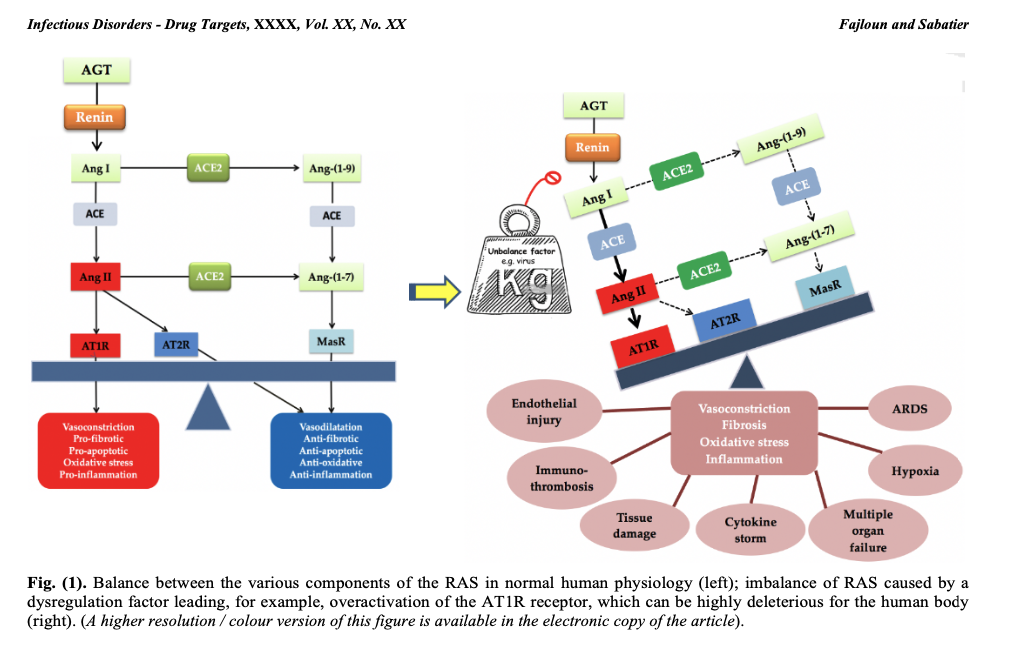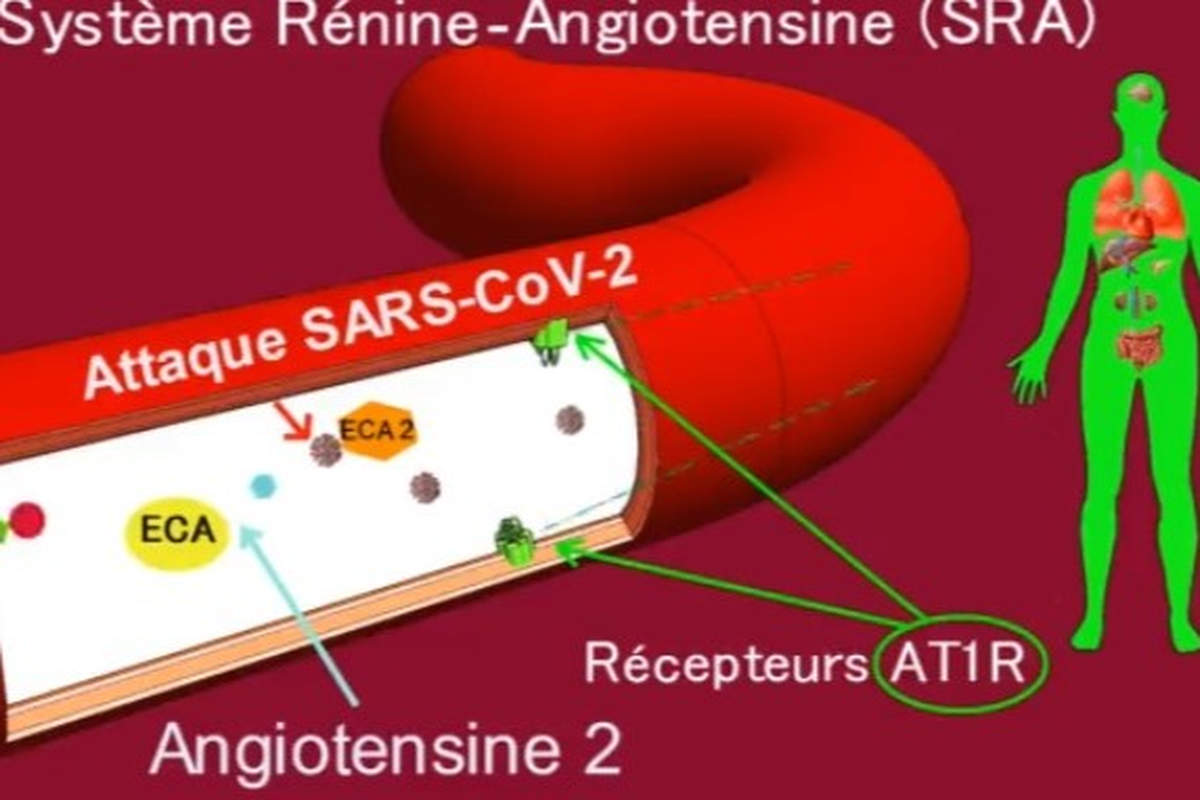May its deregulation be on the root of all human (non-genetic) ailments?

By Jean-Marc SABATIER and Ziad FAJLOUN*
What’s the renin-angiotensin system?
The ever present renin-angiotensin system (RAS), also referred to as the renin-angiotensin-aldosterone system, is a hormonal and physiological system whose operate is to regulate blood strain and circulating blood quantity in people. The RAS additionally regulates pulmonary, cardiovascular, vegetative and renal features, innate immunity and numerous microbiota, together with the intestinal microbiota. The RAS controls autophagy, a mobile regeneration course of that eliminates waste and broken components throughout the cell (a course of initiated after 3 days of fasting). It’s a type of endocrine and enzymatic regulatory cascade. It’s current in all of the physique’s organs and tissues. The RAS has endocrine, autocrine, paracrine and intracrine exercise.
RAS elements are discovered each on the plasma membrane of cells and on the membranes of varied organelles, akin to mitochondrial membranes.
Mechanism of motion: a fragile stability
Within the RAS, renin secreted by the kidney cleaves angiotensinogen (AGT) secreted by the liver to provide angiotensin I (Ang I). The latter is cleaved by angiotensin-converting enzyme (ACE1) to provide angiotensin II (Ang II). Ang II binds to receptors mediating vasoconstriction kind 1 (AT1R) and mediating vasoconstriction kind 2 (AT2R). Ang II can be cleaved by angiotensin-converting enzyme 2 (ACE2) to generate angiotensin (1-7) [Ang-(1-7)], which interacts with the G protein-coupled proto-oncogene Mas receptor (MasR) [7,8] and the AT2R receptor.
Ang II, by performing on the AT1R receptor, exerts a number of deleterious actions, akin to vasoconstriction, fibrosis, apoptosis, thrombosis, hypoxemia, hypoxia, organ hypertrophy, angiogenesis, oxidative stress, irritation and nitric oxide (NO) drop [9]. The enzyme ECA2 counterbalances the results of Ang II/AT1R by cleaving Ang I and Ang II into Angiotensin (1-9) [Ang-(1-9)] and Ang-(1-7), respectively, favorably regulating the RAS.
Thus, a stability between the varied elements of the RAS should all the time be current to make sure correct functioning of the system and physiological regulation. Then again, an imbalance within the RAS could be extremely deleterious to the human organism, as is the case with an infection by the SARS-CoV-2 virus, which interacts with ACE2 (the SARS-CoV-2 receptor and a significant RAS enzyme), resulting in an imbalance within the RAS related to overactivation of the AT1R receptor (see determine 1). COVID-19 signs will finally be linked to RAS dysfunction, as defined in our beforehand printed work.

RAS dysregulation and human (non-genetic) ailments
On this article, we argued that RAS dysfunction is on the root of human (non-genetic) pathologies. Certainly, this goes far past COVID-19. To know this, we have to consider the genetic polymorphism of the actors (totally different elements) of the RAS. Certainly, quite a few research have described sturdy hyperlinks between the genetic polymorphism of RAS elements and the prevalence of particular human ailments. We subsequently imagine that genetic components could predispose the host to various levels of susceptibility to totally different human pathologies.
The prevalence and end result of human ailments have been proven to be linked to genetic and protein polymorphisms of angiotensinogen, angiotensin-converting enzymes 1 and a couple of (ACE1 and ACE2) and the AT1R receptor.
In reality, genetic polymorphism of RAS components can alter their organic actions and expression ranges, resulting in elevated capillary permeability, coagulation, fibrosis and apoptosis in alveolar and different cell sorts.
The Ang II/AT1R axis is the most important pathway that may be affected throughout RAS deregulation. We’ve got beforehand reported that the deleterious episodes following SARS-CoV-2 an infection are the results of overactivation of the Ang II/AT1R axis.
Quite a few deleterious results could be produced by Ang II/AT1R signaling, akin to vasoconstriction, fibrosis, irritation, cell development, migration, organ hypertrophy, thrombosis, manufacturing of reactive oxygen species (ROS) and extra. Mitochondrial dysfunction, DNA injury and cytokine storms end result from overactivation of the Ang II/AT1R axis. Dysregulated RAS elements also can alter and induce an imbalance within the innate/acquired immune response, with an uncommon predominance of hyper-stimulated macrophages, hyper-reactive mast cells and neutrophil granulocytes in affected human tissues.
For instance, experiments have proven that deletion of the AT1R gene in rodents considerably improved important features and lowered oedema formation.
Moreover, within the lung, the Ang II/AT1R axis will increase vascular permeability by releasing prostaglandins and vascular endothelial development issue, as a result of its pro-inflammatory, harmful and pro-fibrotic properties. Certainly, within the case of SARS coronavirus an infection, for instance, the virus invades the airways, vascular endothelial cells and epithelial cells, which might be severely broken, triggering an accumulation of protein-rich edema fluid within the alveoli and pulmonary interstitium, activating macrophages and neutrophil granulocytes to launch a variety of inflammatory components.
Within the cardiovascular system, stimulation of the Ang II/AT1R axis has been related to the event of varied pathologies, together with hypertension, vascular irritation, atherosclerosis and coronary heart failure.
Within the nervous system, elevated Ang II ranges contribute to the lack of neurons in numerous mind areas. Ang II has been proven to trigger the loss of life of dopaminergic neurons, whereas “Losartan”, an AT1R receptor antagonist, protects these neurons from apoptosis.
Within the digestive system, RAS has been proven to induce colonic irritation by stimulating Th17 activation. Within the colonic mucosa, Ang II induces colitis by way of AT1R by way of the JAK2/STAT1/3 pathway. As well as, regulation of the Ang II/AT1R axis can be concerned within the management of dietary amino acid homeostasis (a few of that are precursors of neurotransmitters akin to serotonin, dopamine, adrenaline and noradrenaline, or different NO precursors), antimicrobial peptide expression and microbial flora together with these of the lungs and intestines.
Within the kidney, RAS hyperactivation has been described as taking part in a central function within the development of power kidney illness. Certainly, the Ang II/AT1R axis induces fibrosis and irritation, which seem to contribute to renal pathologies.
Briefly, overactivation of the Ang II/AT1R axis induces deleterious results in people (and mammals basically), as talked about above. Nonetheless, there’s a favorable regulatory system at RAS stage involving gamers akin to ligands Ang-(1-7), Ang-(1-9), Ang IV, alamandin, MasR receptors [10], AT2R, AT4R, MRGD, which by way of cell signaling, can produce anti-inflammatory, anti-fibrotic, anti-proliferative, anti-oxidant (lowering), anti-hypertensive, anti-hypertrophic, anti-angiogenic, anti-hypoxemic, anti-hypoxic and anti-thrombotic results.
It also needs to be famous that the RAS evolves all through life (the RAS of infants differs from that of youngsters, adults and the aged), from start to loss of life. The RAS additionally differs between women and men (the gene coding for the ECA2 receptor is carried on the X chromosome). Omnipresent within the physique at organ, tissue and cell stage, the RAS controls all features associated to mobile life.
This unprecedented international “imaginative and prescient” of the significance of the RAS within the complete management of the functioning of the human physique, in addition to within the potential triggering of varied neurological/neurodegenerative (dementia, Alzheimer’s and Parkinson’s ailments, schizophrenia, and so on.), cardiovascular, gastrointestinal, immune (autoimmunity), cancerous and different pathologies, is unprecedented. It’s “revolutionary” as a result of it has by no means been suspected or described earlier than.
Thus, we emphasize the acute significance of the RAS, a hormonal system initially recognized within the kidneys and liver, however finally current in all tissues and organs. It controls all of the important features of the physique, together with mind and immune features.
In the end, we argue that the RAS is the important thing to all non-genetic, and probably genetic, human pathologies, because it additionally acts on DNA and its restore. For instance, it controls telomerase exercise, which lengthens the ends of chromosomes, thereby growing life expectancy. The RAS is ubiquitous within the physique: there are native variants in numerous tissues and organs (with the identical receptors and ligands concerned however in variable proportions and tissue distribution, tailored to the operate of those tissues/organs) and cells (the RAS is discovered within the outer membrane of cells, but additionally within the membranes of the nucleus, mitochondria, endosomes, exosomes, lysosomes, and within the endoplasmic or sarcoplasmic reticulum). It acts because the central operator of the human physique’s features; it’s not the mind that controls these features, as it’s itself pushed by the RAS. In reality, the RAS controls the features of neurons and different nervous system cell sorts akin to oligodendrocytes, astrocytes and microglial cells.
The RAS is the “grasp” system of the human physique, and subsequently gives unsuspected therapeutic potential. In-depth research of the RAS and its “deleterious” receptor ought to result in main advances in utilized medication within the many years to come back, opening up an immense discipline of medically unexplored analysis.
Jean-Marc SABATIER and Ziad FAJLOUN
November 2023
(Affiliation Internationale pour une médecine scientifique indépendante et bienveillante -AIMSIB)
*Jean-Marc Sabatier is Director of Analysis on the CNRS and holds a PhD in Cell Biology and Microbiology and an HDR in Biochemistry.
*Ziad Fajloun is a researcher on the College of Tripoli.
Covid-19, Covid lengthy and neurological issues

